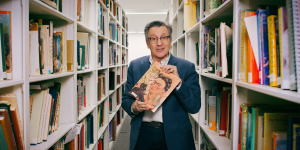T he critic, curator and former gallerist Loïc Malle appreciates artists who were way ahead of their time. Over the past 35 years, Malle has acquired works by figures known for tearing up the rule book, from Land Art trailblazers to Conceptual art visionaries. More than 100 works from Malle’s collection – by Yves Klein, Marcel Duchamp, Walter De Maria and Philip Guston, among others – are included in the sale Only Time Will Tell taking place in Paris on 6 April. “I’m always looking for disruptions, for moments in time that are very important not only for the arts but also for the evolution of the mind. That's basically the life blood of my collection,” he says, describing himself as a “market maverick”.

Malle was born in Brittany, and moved to Paris aged 17, combining his university studies with a burgeoning career in art criticism. His articles were spotted by the photography dealer Virginia Zabriskie who offered him a job at her eponymous gallery in Paris. This experience in the gallery world was a stepping stone to Malle’s next role as an art dealer; in the early 1990s he opened his own gallery on Avenue Montaigne, hosting a number of critically acclaimed shows dedicated to artists such as Robert Rauschenberg and Klein. Today, he acts as an art advisor and works closely with the artist Charles Ross who is building an earthwork, Star Axis, in New Mexico. We asked him about the upcoming sale and how he amassed his eclectic, exceptional collection.
Collection Loïc Malle | Only Time Will Tell
What motivated you to sell the works?
I was not thinking about selling the collection, but Sotheby’s asked if I would consider consigning most of the works. I said: “It's not a collection, it's just an assemblage [reflecting] beautiful encounters with artists, with critics, with galleries. It's about friendship and admiration.” But Sotheby’s said that I have a vision and would “love people to experience it”. I took two days to think about it and decided to go ahead with the sale as the Sotheby’s team is passionate, knowledgeable and hard-working.
I’m keen to know more about the trajectory of your collection—is there a thematic overview?
I started to collect photography at a time when no-one was focusing on the medium. Great historical photographers were still alive in France [in the 1980s]; then I joined Zabriskie Gallery, a pioneer in the photography market in both Paris and New York. In comparison to fine art (painting and sculpture), photography is very conceptual; it's a step into dematerialisation somehow. So this starts with Duchamp, then you get to Yves Klein, then you have the conceptual artists—it's all about the concept, the idea.
Is there also a link between photography and Land Art? There are some superb Earthwork photographs in the Sotheby’s sale including a unique 1970 photograph of Robert Smithson’s Spiral Jetty by Gianfranco Gorgoni.
Yes! The Earthworks needed photography, I think it's very interesting because there is a kind of oxymoron between dematerialisation and monumentality at the same time. The Spiral Jetty is the “Marilyn” of Land Art. This piece, an iconic picture, is a one of a kind that sums up the physical work. This print is unique in size and is central to Smithson’s film Spiral Jetty. Walter De Maria’s High Energy Bar #24 (1966) is just as significant. The accompanying certificate states that without this documentation, the work is not the work. In addition it comes from the late Betty Asher, the most important West Coast collector at the time. These Land Art pioneers or “Troublemakers” as the documentary filmmaker James Crump called them, also questioned the status of art as an object, as a commodity, and therefore disrupted the art market.

The bi-coastal gallerist Virginia Dwan, who funded Spiral Jetty among other major early Earthworks, is considered the godmother of these “Troublemakers”. She became a mentor to you. When did you first meet?
In the late 1980s when she had totally vanished. It took me about a year to track her down and another year to convince her that I should host two tribute shows to her in Paris at my gallery. She was highly educated and at the vanguard of so many European and American movements of the 1960s and 1970s that she wanted to bring to a land then considered a cultural desert (Los Angeles), and to New York also. The National Gallery of Art in Washington DC paid her a magnificent tribute in 2017.
The Conceptual artists featured in the sale, such as Sol LeWitt and Robert Morris, also ruptured the story of art?
Each time I read Sol LeWitt’s statements or definitions, I can’t believe how brilliant and smart he was. I’ve always been bad at maths; to me he is the mathematician of art. The Morris piece that is in the sale, Swift Night Ruler (1963), is extremely important. Apart from a work in the personal collection of Leo Castelli, this is the only piece by the artist from this early period that remains in private hands. It's a key work because it's interactive—the little ruler slides. The spectator becomes part of the work. It also marks the relationship between Duchamp, drawing on his work 3 Standard Stoppages (1913-14) when he was questioning standardised measurements, and Jasper Johns who used rulers in his early 1960s Gray paintings.
The Marcel Duchamp works consigned are significant scholarly items. Les Murs du Restaurant Spoerri, Düsseldorf, comprising an original letter dated 1959 by Duchamp mounted on a photomechanical print, is especially intriguing.
Daniel Spoerri opened his restaurant mostly to cater for his Fluxus art friends; the walls were covered with invitation cards, letters, creating a wallpaper of sorts. Spoerri made a photograph of his wall in Dusseldorf and printed it on canvas, which was a new technique at that time called Editions MAT (Multiplication d'Art Transformable). The original Duchamp letter links to a ready-made that Spoerri was working on for his Editions MAT, which he turned into one of his famous Tableau-Piège assemblages.
Duchamp is my master. For my generation, pre-war writers were intimately connected with pre-war artists through Dada, and Surrealism. I saw my first Duchamp show, in 1978 in a cultural centre in Rennes, Brittany. When I saw that bicycle wheel [Duchamp’s installation dating from 1913], I said: "What the fuck is that?"
Why should connoisseurs of the artist Philip Guston bid on the 1974 work on paper, The World?
If you believe that the group of buildings depicted is also a subliminal forest of [Ku Klux Klan] hoods, which some Guston specialists confirm, this is probably the only large-scale work on paper that gathers all of Guston’s major iconographic themes and motifs on one sheet, in the same drawing. Only a few of his master paintings have this power.
Why does Rashid Johnson’s work appeal to you? The mixed-media piece Tutu (Miles Davis), 2008, stands out.
As an art historian, I have always sought out overlooked art and artists. I was fascinated early on by Black American art and culture, way before it was the zeitgeist. When I was a kid, I’d listen not just to Beethoven and Bach but also Dizzy Gillepsie and Art Tatum thanks to my mum and dad. Johnson is not trying to do white art, he's doing his own art and he's talking politics without being political.
Is Yves Klein a conceptual genius in your eyes?
No doubt, even though he was a megalomaniac though, that was part of the game. His genius came from understanding before everyone that communication is the key to gaining recognition. This is the first time all three of Yves Klein’s works and statements about his pre-science concept of immateriality are gathered, It will probably never happen again (La Terre en Lévitation or La Terre bleue, 1961; Le Saut dans le vide, 23 Oct 1960; Zone de Sensibilité Picturale Immatérielle Série no.1 Zone no.2, receipt to Jacques Kugel, 1959). The latter work foreshadows the NFT phenomenon. It's a revolution.
What comes next? Are you excited by new realms such as the Metaverse?
100% as it’s about the experience—the only concern is where the border lies between entertainment and art. Or maybe it’s part of the dilution between high and low culture. Technology is great but without art it’s only a tool. Collecting is a compulsion, an addiction even. I don’t want to be cured. I still want to discover, learn and enjoy.









